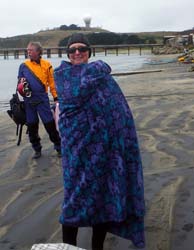Hypothermia is a condition in which an organism's temperature drops below that required for normal metabolism and bodily functions.
Cold water (San Francisco Bay, coastal waters) quickly sucks the heat out of a warm body, and kayakers are therefore especially at risk to become hypothermic, especially if immersed in cold water for extended time.

Symptoms
- Stage 1: Mild to strong shivering occurs. The person is unable to perform complex tasks with the hands; the hands become numb.
- Stage 2: Shivering becomes more violent. Muscle mis-coordination becomes apparent. Movements are slow and labored, accompanied by a stumbling pace and mild confusion, although the person may appear alert. When asked, they often deny having any problems.
- Stage 3: Body temperature drops below approximately 32°C (89.6°F). Shivering usually stops. Difficulty speaking, sluggish thinking, inability to use hands. The exposed skin becomes blue and puffy, muscle coordination becomes very poor, walking becomes almost impossible. The person exhibits incoherent and irrational behavior. This is an emergency situation. Major organs can fail and death can occur.
Prevention
- Dress for immersion, i.e. the water temperature—not the air temperature! Wear a wet suit or dry suit year round.
- Wear your PFD: a PFD can help minimize some of the heat loss by providing a small amount of insulation as well as minimizing movement while in the water.
- Eat plenty and keep your body hydrated. This keeps the body fueled and better able to generate heat.
- Avoid alcohol consumption prior to cold exposure, as it may increase one's risk of becoming hypothermic.
- Keep an eye out for your fellow paddlers. Once a person experiences mild hypothermia, they are much more likely to act imprudently, and much more likely to capsize, which would make their situation more severe.
- Minimize in-the-water time. If a paddler goes for a swim, get them out of the water as soon as is practical.
Treatment
- Mild hypothermia: Treament consists of drying, sheltering, and gradually warming of the patient. Encourage physical activities to generate muscle heat, get the person to a dry sheltered area, and replace wet clothing with dry layers. Offer warm/sweet drinks, energy gels, or easily digestible food. Be persistent in your efforts; hypothermia can reduce a person's capacity for self-care.
- Severe hypothermia: This must be treated as a medical emergency and the patient needs professional help at a medical facility.
Resources
- Water Temperature Table of the Central Pacific Coast: https://www.ncei.noaa.gov/access/data/coastal-water-temperature-guide/cpac.html
- National Center for Cold Water Safety:
- 5 Golden Rules: http://www.coldwatersafety.org/nccwsRules3.html#tabs-3
- Myths & Misconceptions: http://www.coldwatersafety.org/nccwsRules3.html#tabs-4

